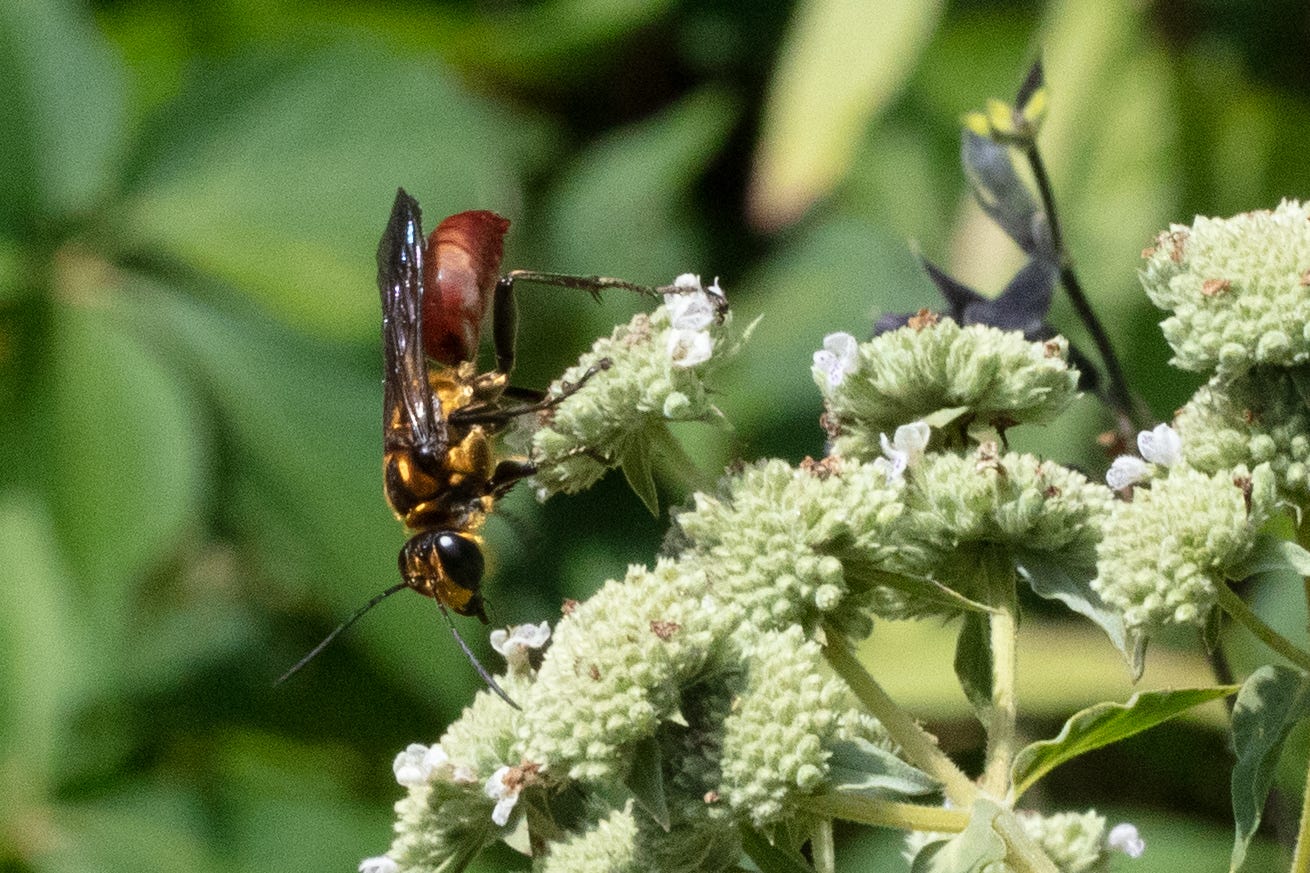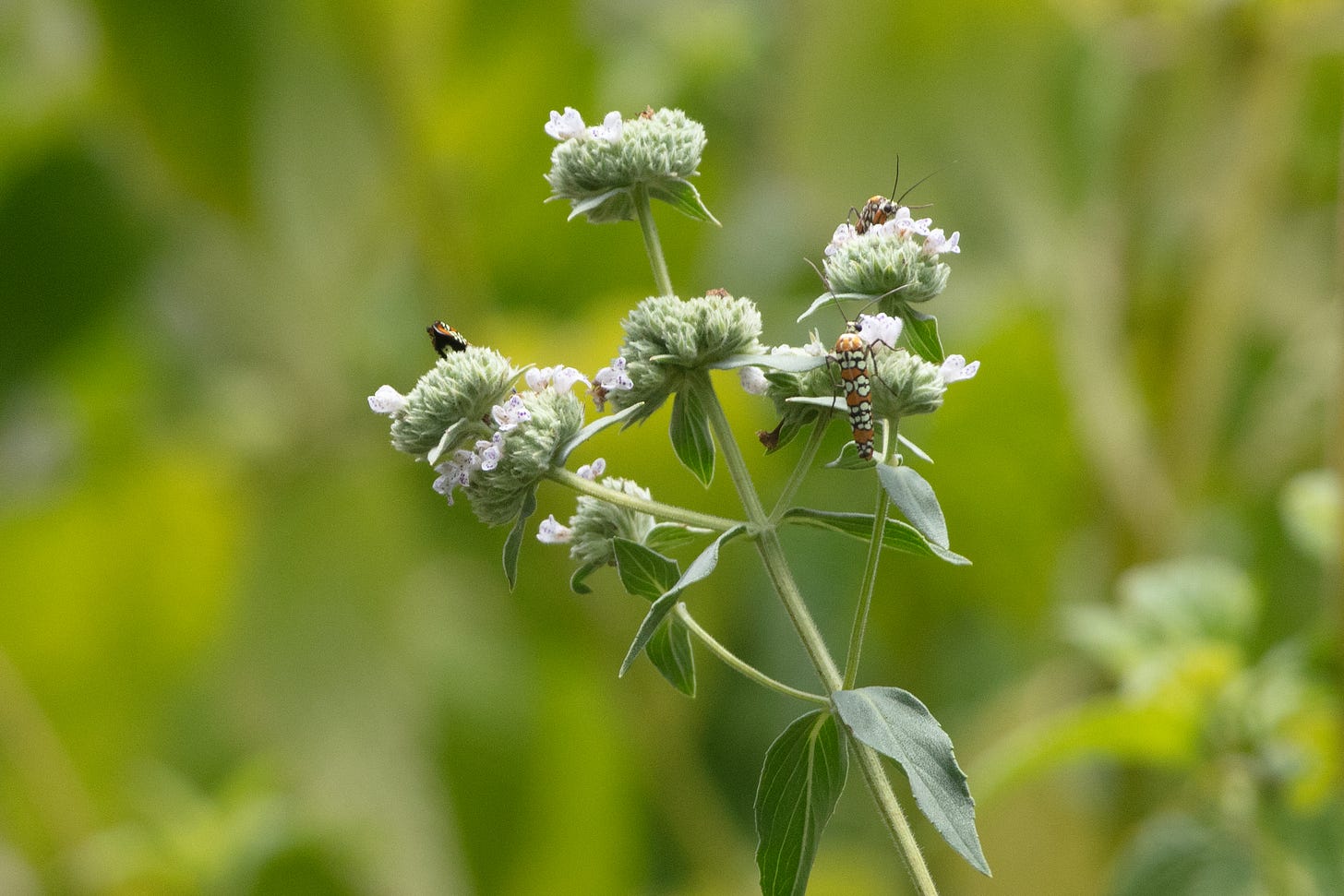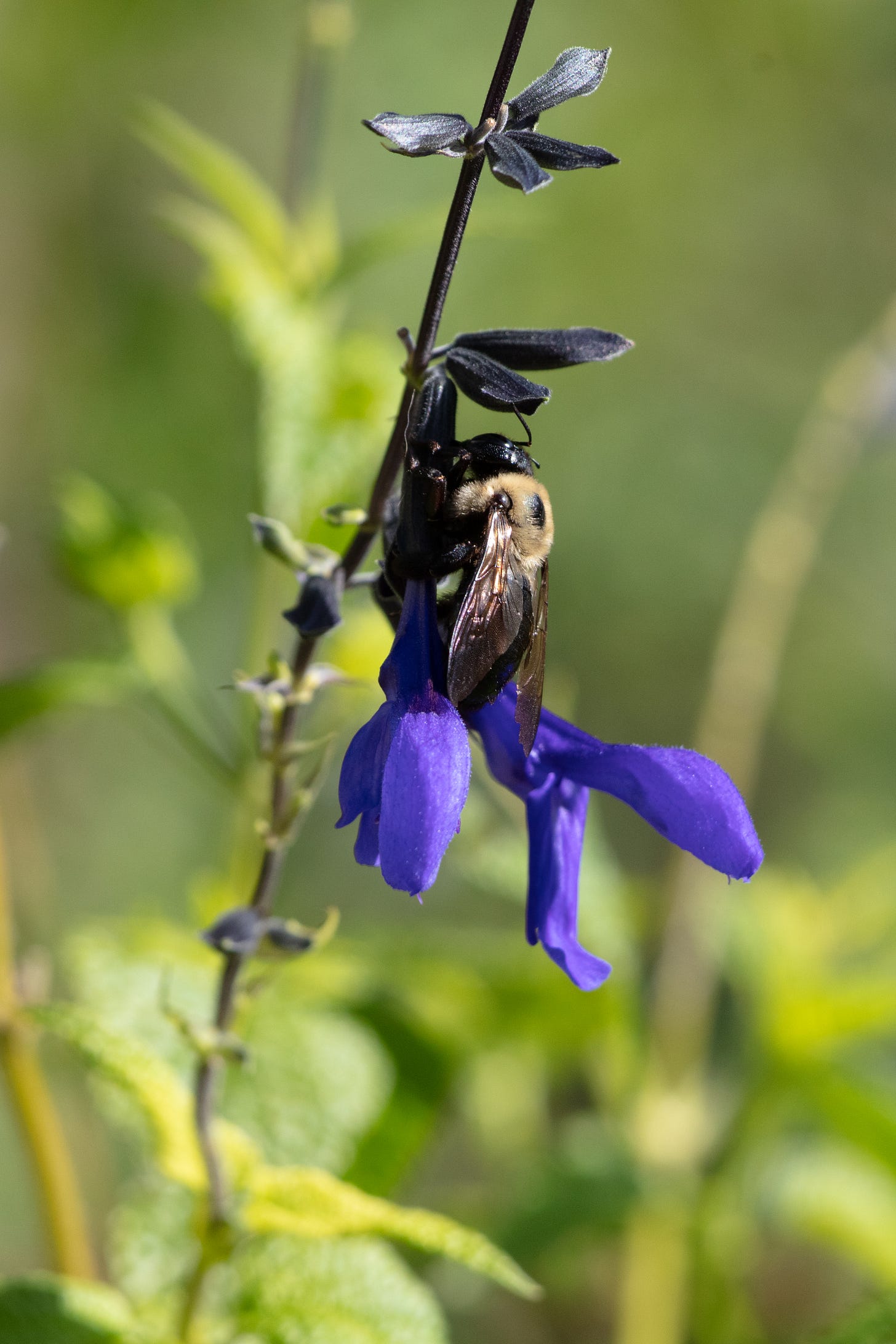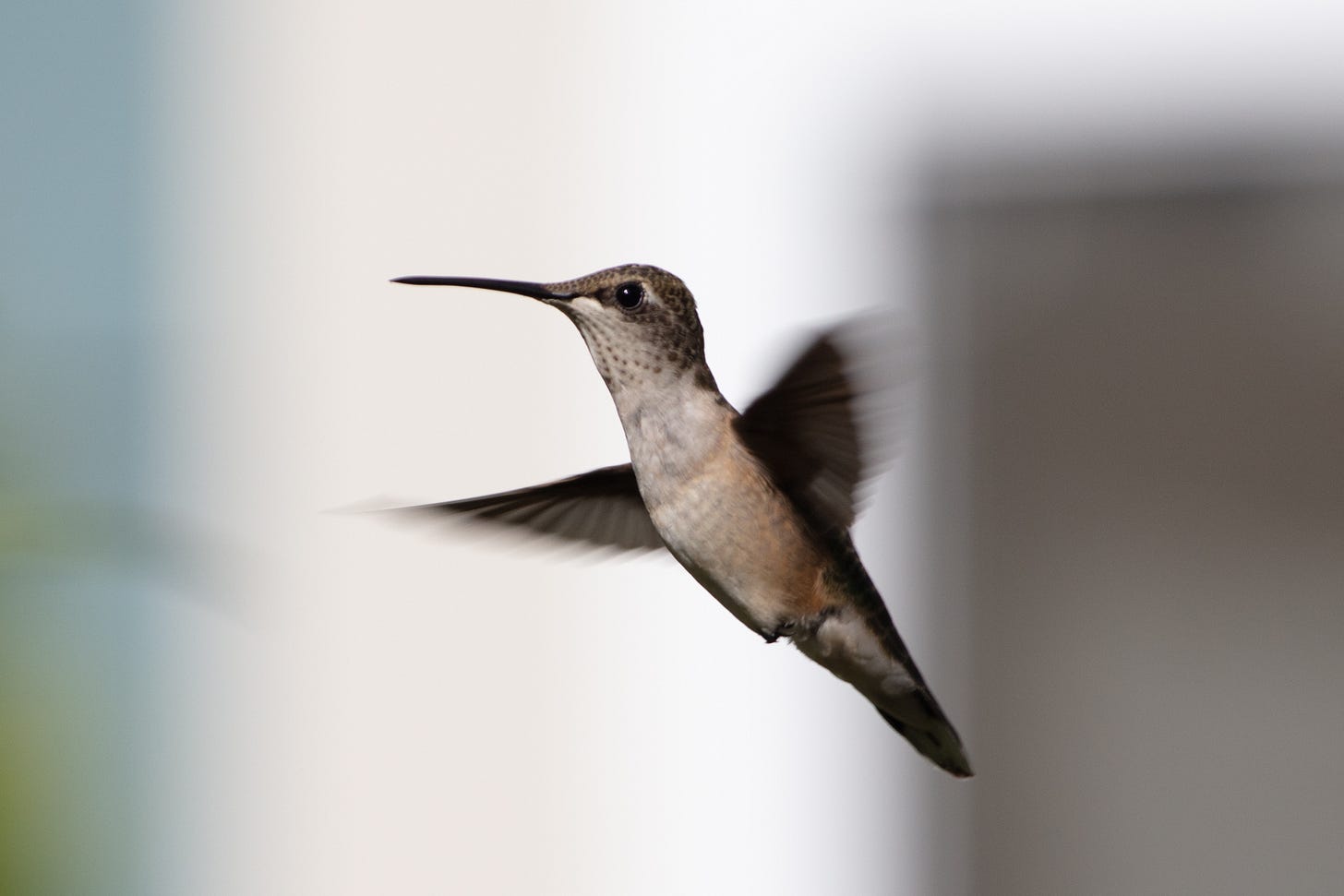Two weeks ago, I documented my observations on a quiet morning from a chair on my back porch. The front yard, which has no porch, is not a place for stationary musing. A series of stone paths weaving between beds of tall perennials, swarmed in summer with birds, bugs, and other wild residents — the front garden is a place of movement.
It is a transient place, for brief observations when leaving or arriving at our home. A green anole by the gutter, a tulip-tree beauty moth pressed to the siding of the house, a brown thrasher busily searching the leaf litter for insect prey. Yesterday morning, from the driveway, I watched a cabbage white butterfly flutter among the spiky spheres of flowering rattlesnake master before resting, wings folded, on the broad, low leaf of a short pokeweed plant. When I came home in the evening, traveling up the front walk, carpenter bees lay curled under the flat umbels of flowering fennel, their bodies forming black half-moon shapes, seeking shelter from the approaching thunderstorm.
The front garden is a place for brief rambles during work-from-home days, to reset after a Zoom meeting or take a thinking break. It is a place for pondering the wording of an e-mail while watching pollinators. A few days ago, during such a mid-morning meander, I stared at a single patch of Pycnanthemum as it hosted a butterfly, a wasp, and three moths.
Pycnanthemum, also known as mountain mint, rises from the red clay of my front yard with branching, stiff, square stems topped with a round, dense cluster of tiny white flowers and pale green, unopened buds. The buds are small and round and remind me of embroidered French knots, tightly packed among the open blooms. Small purple spots speckle the inside of the white flowers. These flowers are, like most if not all mint flowers, bilabiate (two-lipped). Five petals fuse into a floral tube that flares from a narrow base to a wide mouth, with the petals’ five frills — two on top and three on the bottom — forming the two “lips.”
Except for the flowers, the entire plant is a silvery pale green.
As I observed, a gray hairstreak butterfly, Strymon melinus, performed its slow dance on top of one plant, slowly turning in circles while rubbing together its wings. This common butterfly is far from plain, with a few thin lines of black, white, and orange across each wing and a border of bright orange along the forewings, just behind the big, black eyes. At the base of each hindwing are bright orange spots with smaller black spots within, resembling eyes. The edge of the hindwing is scalloped, forming tiny tails. When the butterfly rubs its wings together, the eyespots seem to move.
On the flowers of a mountain mint whose stem had flopped towards the ground, a huge wasp fed on the delicate flowers. Sphex habenus, the golden-reined digger wasp, might seem terrifyingly large, but these solitary wasps are a threat only to insect prey, like katydids, and not people. The wasp’s abdomen is a bright, coppery brown, and golden-yellow fluff covers much of its otherwise black head and thorax.
Nearby, an Ailanthus webworm moth, Atteva aurea, methodically poked its proboscis into the flowers of one plant, while nearby, two of these moths shared a different plant.
Ailanthus webworm moths are one of my favorite species of moth that grace my garden each summer. These day-flying moths have thin, narrow bodies, almost as though they have been rolled into a tube. They have small white faces with big black eyes. Their wings are works of art — bold, bright orange, with a pattern of black-bordered, white circles, a ring of these circles with one in the middle, like a rough drawing of a flower.
Though the adults feed on my garden’s flowers, the caterpillars of this species depend — as the name suggests — on Ailanthus altissima, an invasive tree species commonly known as tree-of-heaven. Atteva aurea is considered a native species, but how did this come to be if its larval host plant is invasive? After years of admiring these orange moths, I looked up the answer to this question. Atteva aurea likely came from further south in the Americas, home to the paradise tree, Simarouba sp., a relative of tree-of-heaven. This suggests that the spread of the invasive tree has enabled the northward expansion of this beautiful moth.
While I watched the moths, a carpenter bee zoomed towards the mountain mint, crashed into a cluster of flowers, and took off without pausing to feed.
Carpenter bees (Xylocopa virginica) have short tongues and cannot reach the base of many bilabiate, mint-family flowers. Perhaps the flowers of mountain mint are small enough for them, but in my garden they seem to prefer the long, slender Salvia flowers. The stems shake as the bulky bees grasp them, crawl to the base of the bright blue blooms, and chew a hole in the flower, giving themselves access to the plant’s nectar despite their tiny tongues — a process called “nectar robbery.” During a recent afternoon thinking break in the garden, I realized that I tend to ignore the numerous, commonplace carpenter bees in the front garden. I made a point to observe them that day, as they chewed up the Salvia.
Lately, however, I’ve observed interesting carpenter bee behavior; they seem to have developed a preference for the small white flowers of Asclepias verticillata, whorled milkweed. I’ve watched them hanging onto these delicate, slender plants, attempting to determine if they are actually feeding on the nectar of the milkweed flowers, robbing its nectar, or just hanging out. They do not seem interested in the orange flowering butterfly milkweed (Asclepias tuberosa.)
A couple of mornings, I’ve tried to sit in the front garden as I do in the backyard, resting with a mug of coffee on the stone steps of the front stoop. I watch three hummingbirds dive and dance through the air, chasing each other away from the feeders I’ve tied to the tall stalks of scarlet hibiscus and tall ironweed. Like the carpenter bees, they enjoy the Salvia, but with their long tongues, they do not have to resort to nectar robbery.
Nearby, the sunshine forms a golden halo around the yellow-fuzzed body of an American bumblebee, Bombus pensylvanicus, a species once common across the country, but whose numbers have dramatically declined in recent years. Each summer, it frequents my garden, and I feel honored to provide it with both space and food. Seeing this bee in a city garden gives me hope.
Silken threads, which could be from a spider or caterpillar, shine silver in the sunlight as they stretch across some of the tall plants in the front garden. Gulf fritillary butterflies float into view, their orange wings showing flashes of white as they flutter. Sometimes they land on the five-lobed, hand-shaped leaves of bluecrown passionflower, laying eggs that will become orange, black-spiked caterpillars who will chew on the leaves and even the passionfruits. Sometimes these butterflies visit flowers; this morning, they favor the orange milkweed (the same orange milkweed that the carpenter bees have ignored.)
A tiny five-lined skink, black body with white pinstripes and an electric blue, iridescent tail, causes a quiet crash by darting under the layers of last year’s oak leaves, which I’ve left in the flower beds specifically for these skinks (among other wildlife.)
A choir of robins sings their repetitive cheery song, phoebes call back and forth, and red-headed woodpeckers give voice to a harsh whir that seems to roll as it travels through the air. Like the American bumblebee, red-headed woodpeckers’ numbers are declining, yet they have found a home in my neighborhood in East Point, Georgia, a city just south of Atlanta that is not known for natural wonders. (I am fairly certain there are no eBird hotspots in the City of East Point.)
Another harsh noise joins the morning chorus — the whine of a chainsaw somewhere on my street. A low roar — some other loud machine — soon joins, like instrumental accompaniment to the wailing voice of the chainsaw. Then the deep growl of a drill makes its entrance, heard in brief, intermittent phrases — the backup vocals in this loud, discordant performance.
The sun climbs above the trees, and suddenly summer heat engulfs the east-facing front yard. The stone stoop steps are no longer cool.
As the heat collects in the garden, so does the volume of insect visitors. Paper wasps visit the hummingbird feeders; a gray weevil slowly makes its way up the front walk; and the garden’s plants host a diverse array of visitors — miniscule neon-striped versute sharpshooters, a single green grasshopper, tiny halictid bees, scoliid wasps, thread-waisted wasps, mason wasps, and the black and white flies that mimic mason wasps — to name a few.
But the heat has begun to settle on my skin like dirt, the chainsaw’s wailing is competing with the cicada song, and it is time to start work. It is time to leave the front garden until the next thinking break.









Somehow, while you beautifully make no judgments and just state factual observations, I feel a shared smile, a chuckle. I chuckled at the bumblebee crashing and moving on, living in the moment.
…pay closer attention to the bees, moths, and butterflies. I’m still wrapping my head around the flowers! Thank you for allowing me to see through your eyes and appreciate the beauty. If you ever come through Athens, give me a holler.